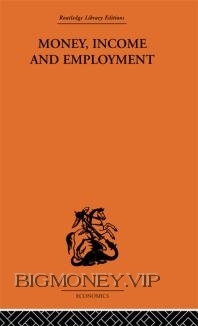
CHAPTER I
The Means of Payment
in the Present-Day Economy
The means of payment, or money, are those assets which may be
used everywhere and at any time in the settlement of claims arising
from the economic process. Let us consider the balance sheets of
individual economic units (households, firms, banks and the govern-
ment) and see which items among the assets are to be regarded as
money at any given moment of time.
1. Let us first consider an inventory of the means of payment of
a household at a given moment of time. As was shown in Vol. I,
the assets (gross wealth) of a household consist of its real wealth and
of claims against other economic units. In general these claims
consist of claims against (a) other households, (b) firms, (c) banks
and (d) the state. Only some of these have the characteristics of
money, namely: (1) the claims against the central bank, held in the
form of notes and coins, Ul and (2) current accounts (demand
deposits) kept with the commercial banks. Time deposits and
savings deposits (i.e. deposits which can be withdrawn only after
agreed notice is given) are not money, since their owner has relin-
quished the right of free disposal for a fixed period of time. However,
they may easily be turned into money by giving the required notice.
Similarly, any bills of exchange, shares and bonds in the possession
of a household are not money.
If, for the sake of simplicity, we regard coins as bank notes printed
on metal (as we did in the first volume) we may say that the means of
payment of a household at any given moment consist of its stock of
notes and its current accounts with banks. Notes are also called
legal tender money, because every economic unit is obliged to accept
them in settlement of debts.
For a household, a current account with a bank is equivalent to
holding an equal amount in notes. The household can convert a part
or the whole of the account into notes at any time, i.e. it can convert
its claim against a commercial bank into a claim against the central
bank. The ownership of a current account thus simply means that
the household has requested the bank to look after part of its cash.
This gives the household considerable advantages in making its
payments. For example, if a household H wishes to settle a claim
held against it by an economic unit U, it may, instead of making
payment in notes, give U a cheque, i.e. an instruction to its bank to
pay U the sum stated on the cheque. If U is willing to accept the
cheque (there is no obligation to do so) he may present it at the
drawer's bank for payment in cash. If U owns a current account at
the drawer's or another bank, he may give the cheque to his bank,
and have the sum credited to his account. In the case where house-
hold H and economic unit U keep accounts with the same bank, the
payment is made simply by the bank's debiting the account ofH and
crediting that ofU. In the case where U keeps an account with another
bank, the process of payment is somewhat different and will be
discussed shortly. In every case, however, payment is made by
debiting the account of H and crediting that of U with the same sum.
Instead of giving U a cheque, household H may simply instruct its
bank to credit the account of U. In this case payment is made in the
same way, by the bank making the appropriate transfer from one
account to the other. In all these cases, the means of payment consist
of current accounts, parts of which are transferred to other accounts
by means of instructions to the banks (by cheque or banker's order).
Since these means of payment consist of entries in the banks' books,
they are often called book money.
2. A consideration of the balance sheets of firms does not shed
any new light on our original question. We merely need to note that
some large firms keep current accounts not only with the commercial
banks but also with the central bank. The firms' stock of money at
any one moment thus consists of (a) their stock of bank notes
(b) their current accounts with the commercial banks, and (c) their
current accounts with the central bank. Both bank notes and current
accounts with the central bank represent immediately realizable
claims against the central bank, and may be called central bank
money. We may say, therefore, that the stock of the means of
payment at any one moment consists of the amount of central bank
money plus the amount of book money held with the commercial banks.
3. We designate the sum of the means of payment held at any one
moment by all firms and households as the stock of money of the
private sector of the economy.
4. Let us now consider the stock of money held by a commercial
bank at any one moment of time. A bank holds at any one moment
a given amount of money in the form of (a) bank notes, (b) current
accounts with the central bank and (c) current accounts with other
banks. The sum of bank notes (including coins) and of current
accounts with the central bank is called the bank's cash reserve.




